
This post explores the immense growth potential of the international ecommerce market. It discusses regional dynamics, emerging trends such as social commerce and voice commerce, and the role of technology in facilitating market entry. Have any questions? Contact our experts.
Reading time: 14 min.
If you’re overseeing your own digital storefront, chances are you’re keen on exploring the nuances of expanding into international markets. Backed by factual information and current statistics, you’ll be equipped with the data to navigate ecommerce more effectively and gain strategic insights for practical success.
So, read this article by the IntexSoft team.
Doing that lets you stay updated on important changes in the global market.
What is global commerce? It’s the process of selling goods or services worldwide, extending beyond the borders of one’s own country. Unlike domestic commerce, which is limited to local borders, global commerce opens doors to a multitude of markets, cultures, and opportunities.
Take a look at some leading players of the market.
eBay operates in nearly 190 countries and territories worldwide, boasting a whopping 132 million buyers on its platform. Amazon isn’t far behind, with a presence in over 100 countries and localized websites in 20 nations. And, of course, there’s Alibaba, connecting buyers and suppliers worldwide, with a significant focus on the bustling Chinese market.

But the story doesn’t end there. Numerous smaller players flourish in the international selling arena just as much as industry giants. Take Allbirds, for example, a global sales platform that ships comfortable shoes to dozens of countries and offers websites in 9 languages.
Presently, there are about 2.64 billion digital buyers globally.
Experts predict that the global ecommerce market will skyrocket to nearly USD 57.22 trillion by 2032, marking a significant surge from its 2024 valuation of USD 18.71 trillion. This growth trajectory translates to a steady compound annual growth rate of 15% from 2024 to 2032. So you can gauge the pace of growth.
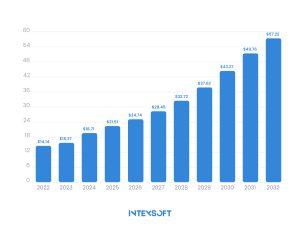
Presently, the B2B sector dominates the market, commanding the largest share. Recent analyses suggest its sustained relevance in the foreseeable future. This trend is evident upon examining the detailed ecommerce industry statistics presented in the image below:
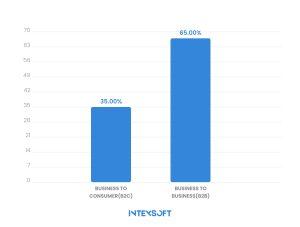
As you can discern from the stat above, the market presents a multitude of opportunities for store owners in the next decade. The ecommerce industry is on a trajectory of rapid and sustained growth worldwide.
Now, let’s delve into the dynamics in more detail. To thoroughly understand the landscape, we will provide an overview of how the situation varies across different regions and categories of goods and services.
Four years ago, Latin America emerged as a hotspot for ecommerce growth, led by Argentina, with an impressive sales surge of over 70%. The lifting of pandemic restrictions in Buenos Aires prompted citizens to practice cautious social distancing, driving online shopping trends. Meanwhile, Singapore also stood out, implementing supportive policies to boost its digital industry and contribute to the overall ecommerce growth in the region. Government policy is one of the prime factors that can impact the growth of an online store.
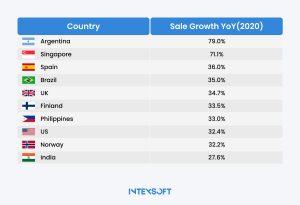
In 2023, the situation changed, and the USA and China emerged as the dominant players.
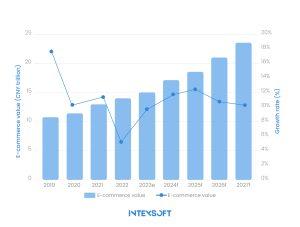
In the thriving realm of China’s ecommerce, major platforms like Taobao, JD.com, and Douyin stand as pillars of innovation, constantly adapting to meet the ever-changing demands of online consumers. Their ingenuity has propelled significant growth in the sector, shaping China’s dominance in the global ecommerce arena.
Meanwhile, in the USA, the ecommerce landscape is fueled by a multitude of factors driving its expansion:
Now, let’s unravel the growth prospects of both the USA and China in ecommerce and examine how their trajectories stack up against each other.
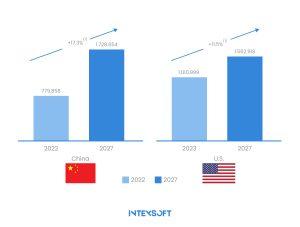
Assess what are the most spending categories in international ecommerce from the data above:
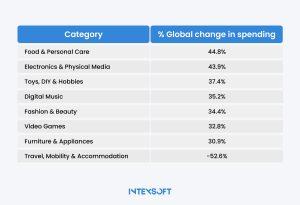
Popular product categories by region
| Region | Current situation | Popular product categories |
| North America | The ecommerce scene in North America, led by the United States, boasts a mature market where online shopping is widely embraced. | Ecommerce platforms in this region constantly innovate and branch out into diverse product categories. We can’t select a few. |
| Europe | – Europe, home to countries like the UK and Germany, enjoys a strong presence in ecommerce. – European shoppers prioritize convenience and digital payment options when making online purchases. | Fashion, electronics, and groceries. |
| Asia-Pacific | Asia-Pacific, with heavyweights like China and India, is experiencing rapid growth in ecommerce, mainly driven by mobile commerce. | Beauty & fashion products, electronics, and household products. |
| Latin America | – Brazil and Mexico are witnessing a surge in ecommerce. – International ecommerce platforms tailored to the specific needs of consumers in these regions are gaining popularity. | Especially sectors like fashion and electronics. |
| Middle East and Africa | – The Middle East and Africa are witnessing a rise in ecommerce activity. – Digital payment methods are gaining traction in this region, indicating a shift towards online transactions. | Beauty, personal care, and food and grocery segments. |
| Rest of the world | – Various countries around the globe are showing increasing interest in e-commerce, offering opportunities for global players. – Factors such as improved internet connectivity and growing digital literacy contribute to the rise of ecommerce in these areas. | All product categories. |
Social commerce is projected to experience a compound annual growth rate of 31.6% from 2023 to 2030.
As social media has revolutionized how consumers engage with online shopping, people rely on recommendations from trusted influencers on popular platforms. Among the most ubiquitous are Facebook, Instagram, and Twitter.
Furthermore, social media platforms have integrated ecommerce features such as shoppable posts, in-app checkout, and “Buy Now” buttons. These features make it easier than ever for users to access product pages and complete purchases directly, enhancing the overall shopping experience.
A notable increase in mobile commerce is a major trend in retail in the coming years. Industry forecasts paint a promising picture. They anticipate a remarkable surge in this area’s sales, projected to soar to $3.4 trillion by 2027. More and more people are choosing the convenience of mobile devices, especially through shopping apps, for their online purchases each year.
The surge in mobile commerce presents vast opportunities for retailers to tap into a global audience of digitally-savvy consumers. By embracing mobile-first strategies, optimizing their online platforms for mobile devices, and leveraging cutting-edge technologies such as augmented reality (AR) and virtual reality (VR), businesses can provide immersive shopping experiences.
With the ability to browse, compare, and make purchases on-the-go, anytime and anywhere, customers enjoy greater convenience and flexibility. Additionally, embracing mobile payment solutions and streamlining the checkout process can further enhance convenience and security for mobile shoppers.
By capitalizing on this burgeoning trend, businesses can position themselves ahead.
As smart speakers and virtual assistants gain traction among consumers, voice commands are becoming a popular way to shop online.
Analysts predict substantial growth in voice commerce sales. In 2024, voice commerce is anticipated to experience a robust growth of 54.63%.
Retailers can seize this opportunity by fine-tuning their websites for voice search functionality, creating seamless voice-enabled shopping experiences, and integrating with popular voice assistant platforms such as Amazon Alexa and Google Assistant. By embracing voice commerce, retailers can enhance the accessibility and convenience of their online shopping platforms, meeting the evolving needs of tech-savvy consumers.
By comprehending the intricacies of international markets, companies can unlock vast opportunities for growth and success. Whether embracing social commerce, capitalizing on the mobile shopping revolution, or tapping into emerging trends like voice commerce, businesses must stay agile and innovative to establish themselves in the digital marketplace.
If you have any questions or need expert advice on international ecommerce solutions, feel free to reach out to us at IntexSoft. We’re here to help anytime you need assistance.